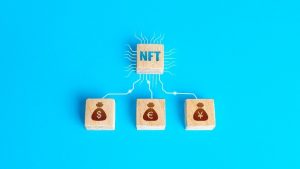
Collectors and investors are scrambling to add such digital collectibles to their portfolios. The effect is a significant impact on the wider token and digital asset market. Indeed, NFTs have emerged from the market periphery into a space where organisations as well-known as the U.S. National Basketball Association (NBA), Spanish football’s La Liga, auction house Christie’s and others, now have products and teams/operations dedicated to supporting their NFTs.
While digital collectibles have driven many headlines, the real-world application of NFT technology is even broader with applications across multiple sectors. NFTs are, therefore, more than a fad. Businesses, regulators, governments and authorities all, in different ways, stand to benefit if they are able to harness the potential of NFTs.
What is an NFT?
Deciding what an NFT is matters. At its most basic, an NFT is a unique online, digitally-generated asset (or unit of data) which can exist on a blockchain. An NFT’s uniqueness is what defines it.
For example, someone can own a digital file, but these files tend to be vulnerable to unauthorised replication because they lack an in-built function of recording and maintaining unique ownership. In contrast, NFTs possess this capability for uniqueness, suggesting that the range of potential applications for this enabling technology could be vast.
The cost of replicating an item in the digital world is next to nothing. Illegally downloading items – for example, copying and pasting images – infringes upon the rights of owners and content creators. This ‘ability’ makes for a chaotic market, one rife with plagiarism as well as illegal profiteering.
While use of blockchain technology does not prevent this, blockchain NFTs do allow the unique recording of the ownership of assets or other items to be recorded. Once recorded, sharing, publishing and efficient trading becomes possible across one or multiple venues. NFTs also enable the payment of royalties to the original content creators – regardless of where or how the sale of NFT items occur.
Attracting more attention
For instance, Christies (the auction house) made its third largest sale in history, of US$69M, with a digital artwork NFT by Beeple. Damien Hirst recently sold 10,000 individual artwork NFTs in the Currency Project for $2,000 each (see below). The following day those NFT’s were on sale for $4,000 in the secondary market. Over the next 30 days individual Currency NFT’s changed hands for up to $70,000, with over US$50M of Currency artwork changing hands.
Such an active secondary market would not be possible without the NFT digital token as the key component. In the case of the Currency Project, each digital NFT represents a physical artwork held in a vault that can be claimed by the owner of the NFT 12 months after the initial sale. Should the owner of an NFT decide to:
- claim the physical piece, the digital NFT will be destroyed
- keep the digital token, the physical artwork will be destroyed
As sales of NFTs continue to break records – one individual made a reported US$1.23M within a few hours after flipping a CryptoPunk – it should come as no surprise that regulators and large institutions are taking notice. Issues of income and tax as well and laundering are rising up ladders of regulatory concern. Beyond these, there are bigger questions facing the market.
Do others stand to benefit?
The world is still exploring NFTs and its use cases. The most common and recognised use case for NFTs is in the digital art market. To protect the interests of artists and owners, NFT blockchain technology offers an un-editable record which, in a world of common copyright infringement and duplication, is a necessity in any battle against plagiarism. (Readers should note that an NFT alone does not provide any legal ownership rights. An NFT merely provides a tradeable digital record. In some cases, a digital record may suffice. In other cases, there may be a requirement for legal agreements to describe and establish the rights of NFT token holders).
What is already apparent is that the associated technology is far more transferable than being just for the exchange of digital assets.
A common language?
The explosion of NFT’s in the art world has increased awareness, making NFT a commonly used term used to describe unique tokens. Such a common language is powerful. It enables people to imagine the technology in use in other fields, from digital sports club collectibles to fractionalised ownership of physical assets such as real estate.
In this way, NFT’s bring introduce liquidity to previously illiquid assets. This happens through enabling ownership to change via digital platforms, especially those with global reach.
This trading can be extremely efficient. It requires fewer intermediaries than traditional markets. By replacing such intermediaries with digital guarantees that enable safe and simple ownership transfer, NFTs possess the potential to facilitate asset-buying processes. All past accounts of ownership and rights can record on a blockchain – and are instantly verifiable.
NFTs could also allow fractional ownership in assets such as property. This would mean property owners could unlock value from their properties and then raise funds without the assistance of multiple parties. Indeed, this approach this could apply to the sale and exchange of businesses, or investments in sport star equity, whether in part or in their entirety.
In effect an NFT standard means items purchased in one marketplace may be taken and sold in another. This flexibility introduces additional liquidity.
Integration of cryptocurrencies and stable coins in NFT marketplaces enables, therefore, seamless delivery vs payment for NFT. This happens through the adoption of smart contracts, further:
- increasing efficiency and speed of trade
- reducing custodial risk or the need for escrow
In addition, decentralised finance (DeFi) could offer loans against digital assets including NFTs. An NFT of a high value artwork could then become part of a smart contract. Held there it would act as collateral when the owner obtained a loan.
Conclusions
We are still in the early days of NFT and related technologies. Yet, the above examples should highlight the ease of transferability of NFTs. Currently, there are an estimated US$78T of non-bankable properties around the world. This includes all manner of items, such as fine wine, rare stamps, real estate, famous art and other collectibles.
Applied Blockchain has already built major NFT marketplaces for some of the world’s leading artists for both digital and physical art, as well as a platform for fine wine collections. NFTs are attractive because they offer a means for releasing the inherent value and in doing so they create liquidity. It should be no wonder NFTs are generating such excitement across so many markets.


























